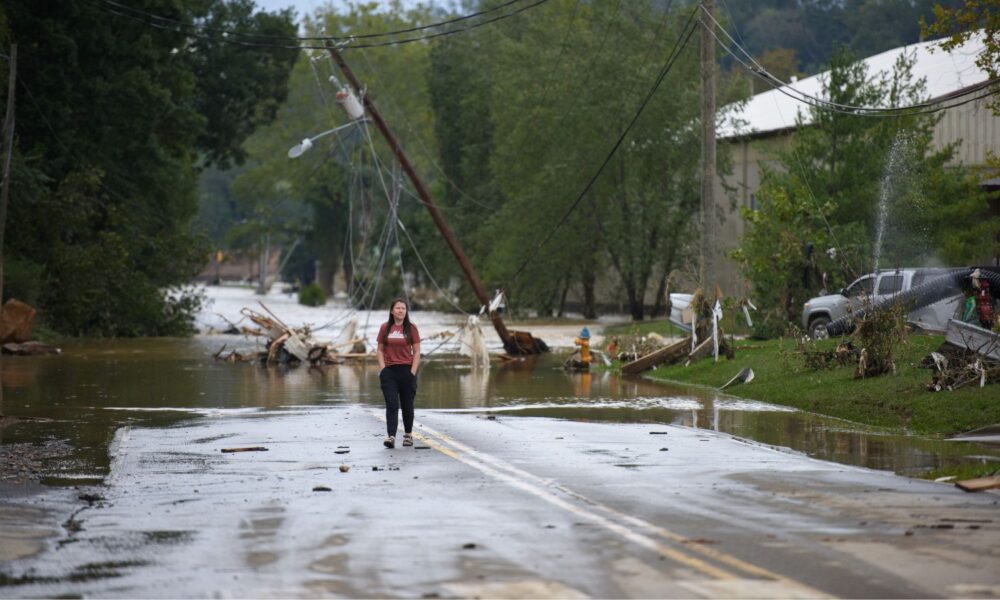In recent weeks, the Trump administration has ramped up attacks on climate science, data, research and scientists across the board—including jeopardizing the National Climate Assessment, halting the publication of data on billion-dollar climate and weather disasters, and stopping federal agencies from using the social cost of carbon to create policies. Behind these individual instances of harm is a clear strategy: they want to bury the scientific evidence of the impacts and economic damages caused by climate change to avoid having to take any action to address them.
But climate change is all too real, and there’s no getting away from the many ways it’s showing up in our daily lives, from catastrophic wildfires and floods to rising property insurance costs. To limit the public health and economic costs of the climate crisis, the country must transition quickly from fossil fuels to clean energy and invest in resilience—but of course the Trump administration is hell-bent on doing the exact opposite. And what better way to boost fossil fuels than to hide the facts on their true costs and spread lies and propaganda instead?
Yes, climate change is contributing to billion-dollar disasters
For over four decades, NOAA has been tracking and collecting data on US extreme weather and climate-related disasters with costs exceeding a billion dollars. Last week, NOAA announced that it will no longer be updating this dataset beyond 2024. Specifically: “In alignment with evolving priorities, statutory mandates, and staffing changes, NOAA’s National Centers for Environmental Information will no longer be updating the Billion Dollar Weather and Climate Disasters product.” For now, the dataset and documentation spanning 1980-2024 will remain available at this landing page. An external consortium of researchers has also saved it in a Harvard Dataverse repository.
The motivation couldn’t be clearer: this dataset is uncomfortably inconvenient because, among other things, it shows that climate change is costly, right now, across the nation. That reality doesn’t sit well with an administration that peddles climate disinformation, going as far as to call it “a hoax.”
A look at the 2024 map is revealing: billion-dollar disasters hit every region of the country and many of them—including Southwestern wildfires, extreme heat and drought, as well as several intensified hurricanes in Gulf Coast states and the Southeast—were worsened by climate change. Of course, other important factors are also at play, including the increase in development along coastlines and other places exposed to disasters. More expensive property and infrastructure exposed to climate-fueled disasters contribute to higher damage costs.
The extreme weather we experience today is occurring in the unavoidable context of a warming world—the roughly 1.3˚C (2.3˚ F) increase in global average temperature over the 20th century average that we have already seen is now baked into the background conditions in dangerous ways. In 2024, the hottest year on record following on a decade of hottest years on record, the global annual average temperature was about 1.5˚C (2.6˚ F) above pre-industrial (1850-1900) levels.

In 2024 alone, the nation experienced 27 individual billion-dollar weather and climate disasters, which together caused at least 568 direct or indirect fatalities and cost approximately $182.7 billion in total. The most catastrophic by far was Hurricane Helene, a Category 4 hurricane that hit Florida and traversed far inland to Georgia and North Carolina, causing 219 deaths and approximately $79.6 billion in economic damages, according to NOAA. The hurricane was intensified by record warm waters in the Gulf of Mexico, and it drove storm surges of up to 15 feet in the Big Bend coastal area, and caused historic rainfall of up to 30+ inches in western North Carolina.
As my colleague Dr. Marc Alessi noted last year: “Helene was an example of what hurricanes will look more like in the future. With ocean surface temperatures more than 2 degrees Celsius above normal in the Gulf of Mexico and Caribbean Sea, Helene was able to rapidly intensify to a Category 4 hurricane before making landfall in Florida.”
While many factors contributed to the destruction caused by Helene, climate attribution studies (for example, here) show that:
- The overall rainfall amounts associated with Helene were about 10% heavier due to climate change, and as much as 50% heavier in parts of Georgia and the Carolinas. The rainfall totals over the 2-day and 3-day period were made about 40% and 70% more likely by climate change, respectively.
- In general, climate change is enhancing conditions more favorable to rapid intensification of Atlantic tropical storms, and more conducive to those storms carrying heavy precipitation.
The long-term trend data on billion-dollar disasters is also striking. Adjusted for inflation, the annual average number of these events for 1980–2024 is 9.0 events (Consumer Price Index-adjusted); the annual average for the most recent 5 years (2020–2024) is 23.0 events (CPI-adjusted). Their costs, too, have risen since 1980, even after adjusting for inflation. The highest cost years are all post-2000.

Hiding this data doesn’t make us safer. It only hinders our ability to take protective action, based on facts, to limit harms to communities, infrastructure, and critical economic assets. Those actions include: limiting the heat-trapping emissions driving climate change by transitioning away from fossil fuels and ramping up clean energy, while using energy more efficiently; and investing in climate resilience, including by enhancing pre- and post-disaster response, ramping up adaptation measures, and thinking carefully about where and how to build in disaster-exposed places.
The social cost of carbon shows that fossil-fueled climate change is costly
In another blatant anti-science move, the Trump administration has also issued a directive to stop federal agencies from using the social cost of carbon in their actions. The social cost of carbon is a widely accepted economic metric that puts a dollar value on the damage caused per ton of heat-trapping emissions, allowing federal agencies to set policies and regulations that take those costs into account. In economist-speak, this is just a commonsense way to correct a market failure and internalize the climate-driven externality costs of using fossil fuels.
The social cost of greenhouse gases (SC-GHG) helps quantify the costs of climate change related to heat-trapping emissions, in terms of dollars per ton of carbon dioxide (CO2) or methane (CH4) or nitrous oxide (N2O) emitted. It can also be used to quantify the benefits of reducing these emissions. Based on science, this metric simply underscores the obvious: climate change is costly and right now, many of the costs are falling to society at large instead of being assumed by fossil fuel companies and others who are making decisions that ultimately determine how much of these pollutants are emitted.
How costly? Well, the latest estimates of the social cost of greenhouse gases from the EPA—before the Trump administration’s attempts to gut them—are summarized in the table below. The dollar costs of a ton of CO2 emitted in 2020, using a 2% discount rate, are $190. These estimates are based on cutting-edge climate science and economics, and went through an extensive peer-review and public comment process. If anything, these are underestimates of the true costs because of the challenges of monetizing many categories of climate harms (e.g. ecosystem damages).
One additional important area of continued improvement is the recognition that estimating damages over long periods, especially those that are profound, long-lasting, and even irreversible, requires a different approach to the choice of discount rates. Estimating dollar values also comes with important justice and ethical considerations because of the multi-generational, global nature of climate damages.

Now, the Trump administration wants to eliminate any consideration of these costs by fiat. Yup, they want to force us to act as if the costs of climate change are exactly zero, even as extreme heatwaves take a deadly toll, people are losing their homes, farmers face dire crop failures, and businesses are experiencing costly disruptions! Guess who that crooked math benefits? Fossil fuel companies and other polluters, who don’t want to limit their egregious profits and want to keep dumping the rapidly growing costs of their harmful products on all of us.
As climate scientist Dr. Robert Kopp said in a recent New York Times interview: “By effectively saying the social cost of carbon should be treated as zero, this policy arbitrarily and capriciously ignores the science and economics of climate change.”
Jeopardizing the National Climate Assessment (NCA) doesn’t stop climate change
In another assault on science last month, the Trump administration fired the staff of the US Global Change Research Program (USGCRP) and soon followed that by disbanding the author team for the sixth National Climate Assessment. As one of the 400+ volunteer authors, I received an email stating that “the scope of the NCA6 is currently being reevaluated,” but the administration has yet to announce any plan for how it will deliver on this Congressionally mandated comprehensive climate science report.
People around the nation rely on the NCA to understand how climate change is impacting their daily lives already, and what to expect in the future. While not policy-prescriptive, the findings of these quadrennial reports underscore the importance of cutting heat-trapping emissions and investing in climate resilience to protect communities and the economy. Trying to bury this report won’t alter the scientific facts one bit, but without this information our country risks flying blind into a world made more dangerous by human-caused climate change.
The only beneficiaries of disrupting or killing this report are the fossil fuel industry and those intent on boosting oil and gas profits at the expense of people’s health and the nation’s economic well-being. Congress must step up to ensure the report it requires by law is conducted with scientific integrity and delivered in a timely way.
Rigging the facts to benefit polluters
This recent series of actions underscores the Trump administration’s ongoing strategy of rigging the math to put a thumb on the scale in favor of polluters while saddling the rest of us with the costs. It’s all shamefully clear and premeditated.
Drastically slashing the social cost of carbon was a tactic used during the first Trump administration, when the administration lowered the value to $1-$7 per ton (see Table 4-1 in the link). The Project 2025 manifesto took an even more aggressive approach, saying that the President ‘by executive order should end the use of SCC analysis.’ The last Trump administration also tried to bury the fourth NCA by releasing it the day after Thanksgiving—which ironically back-fired and only served to give it more attention! In its second term, the Trump administration’s actions have escalated well beyond those taken in the first term. Now the goal seems to be to get rid of scientific data, facts, and research entirely—for example, as EPA’s Administrator Lee Zeldin is trying to do with a “reconsideration” of the Endangerment Finding, or via the administration’s wholesale attacks on NOAA.
We need Congress to step up and ensure we have policies and outcomes guided by the best available science to help protect lives and our economy, especially as the climate crisis worsens.
This is not just ordinary politics and run-of-the-mill disagreements on policy details. More disturbingly, it’s become increasingly clear that the Trump administration is following the classic playbook of authoritarian regimes. Burying facts and replacing them with propaganda is a way to exert control over independent thought and consolidate power. People who care about science and facts must resist this dangerous turn and protect the democratic institutions that allow free thought to flourish.

